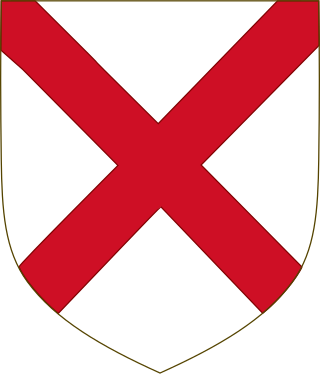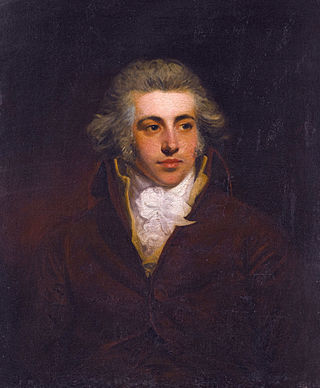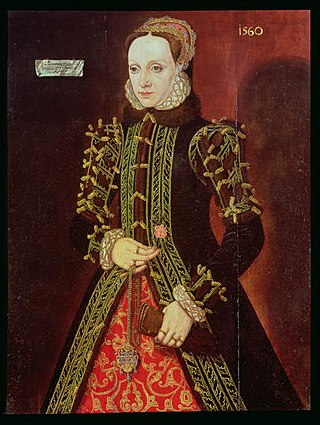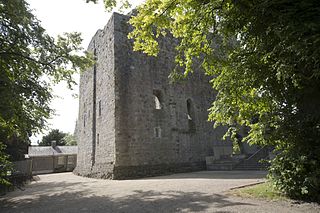| |||||
| Centuries: | |||||
|---|---|---|---|---|---|
| Decades: | |||||
| See also: | Other events of 1513 List of years in Ireland | ||||
Events from the year 1513 in Ireland.
| |||||
| Centuries: | |||||
|---|---|---|---|---|---|
| Decades: | |||||
| See also: | Other events of 1513 List of years in Ireland | ||||
Events from the year 1513 in Ireland.

Duke of Leinster is a title in the Peerage of Ireland and the premier dukedom in that peerage. The subsidiary titles of the Duke of Leinster are: Marquess of Kildare (1761), Earl of Kildare (1316), Earl of Offaly (1761), Viscount Leinster, of Taplow in the County of Buckingham (1747), Baron of Offaly, Baron Offaly (1620) and Baron Kildare, of Kildare in the County of Kildare (1870). The viscounty of Leinster is in the Peerage of Great Britain, the barony of Kildare in the Peerage of the United Kingdom, and all other titles in the Peerage of Ireland. The courtesy title of the eldest son and heir of the Duke of Leinster is Marquess of Kildare. The Duke of Leinster is the head of the House of Kildare.

The FitzGerald dynasty is a noble and aristocratic dynasty of Cambro-Norman and Anglo-Norman origin. They have been peers of Ireland since at least the 13th century, and are described in the Annals of the Four Masters as having become "more Irish than the Irish themselves" or Gaels, due to assimilation with the native Gaelic aristocratic and popular culture. The dynasty has also been referred to as the Geraldines and Ireland's largest landowners. They achieved power through the conquest of large swathes of Irish territory by the sons and grandsons of Gerald de Windsor. Gerald de Windsor was the first Castellan of Pembroke Castle in Wales, and became the male progenitor of the FitzMaurice and FitzGerald Dynasty. His father, Baron Walter FitzOther, was the first Constable and Governor of Windsor Castle for William the Conqueror, and was the Lord of 38 manors in England, making the FitzGeralds one of the "service families" on whom the King relied for his survival.
The Lord Deputy was the representative of the monarch and head of the Irish executive under English rule, during the Lordship of Ireland and then the Kingdom of Ireland. He deputised prior to 1523 for the Viceroy of Ireland. The plural form is Lords Deputy.
Gerald Fitzgerald may refer to:
The Battle of Knockdoe took place on 19 August 1504 at Knockdoe, in the Parish of Lackagh, County Galway, between two Anglo-Irish lords—Gerald FitzGerald, Earl of Kildare, the Lord Deputy of Ireland, and Ulick Fionn Burke, 6th Clanricarde (d.1509)—along with their respective Irish allies. The cause was a dispute between Maelsechlainn mac Tadhg Ó Cellaigh (O'Kelly), King of Ui Maine – Mod. Irish Uí Mháine) and Clanricarde. The major contemporary sources for this battle are the Gaelic Irish annals and a sixteenth-century manuscript written in the Pale known as "the Book of Howth".

Lord Henry FitzGerald PC (Ire) was the fourth son of the 1st Duke of Leinster and the Duchess of Leinster. A younger brother was the revolutionary Lord Edward FitzGerald.

Gerard FitzGerald, 9th Earl of Kildare, was a leading figure in 16th-century Irish History. In 1513 he inherited the title of Earl of Kildare and position of Lord Deputy of Ireland from his father.
Events from the year 1491 in Ireland.
Events from the year 1504 in Ireland.
Events from the year 1510 in Ireland.

Elizabeth FitzGerald, Countess of Lincoln, also known as "The Fair Geraldine", was an Irish noblewoman and a member of the celebrated FitzGerald dynasty. She became the second wife of Sir Anthony Browne and later the third wife of English admiral Edward Clinton, 1st Earl of Lincoln. She was the inspiration for The Geraldine, a sonnet written by Henry Howard, Earl of Surrey.

Thomas FitzJohn FitzGerald, 7th Earl of Kildare, was an Irish peer and statesman of the fifteenth century who held the office of Lord Chancellor of Ireland.
Lady Elizabeth FitzGerald, Countess of Kildare, was an Anglo-Irish noblewoman, the second wife of Gerald FitzGerald, 9th Earl of Kildare. Her father was Thomas Grey, 1st Marquess of Dorset. Her mother, Cecily, was the wealthiest heiress in England after succeeding to the title of suo jure 7th Baroness Harington of Aldingham and then the title of suo jure 2nd Baroness Bonville.
Donal MacCarthy Reagh was the 12th Prince of Carbery from 1505 to his death in 1531. He belonged to the MacCarthy Reagh dynasty, and was the son of Finghin MacCarthy Reagh, 10th Prince of Carbery, and Lady Catherine FitzGerald, daughter Thomas FitzGerald, 7th Earl of Desmond.
Lucas More Plunket of Killeen, County Meath, styled Lucas Môr, tenth lord Killeen, created Earl of Fingall on 26 September 1628, was an Irish peer.
Philip Flattisbury, was an Irish compiler.

Gerald FitzGerald, 8th Earl of Kildare KG, known variously as "Garret the Great" or "The Great Earl", was Ireland's premier peer. He served as Lord Deputy of Ireland from 1477 to 1494, and from 1496 onward. His power was so great that he was called "the uncrowned King of Ireland".
Sir William FitzWilliam, of Windsor, Berkshire, was an Irish courtier and Member of Parliament in England. He was Chief Gentleman of the Privy Chamber to Edward VI of England; Deputy Chancellor of Ireland; Lieutenant of Windsor Castle; Keeper of Windsor Great Park and Lord Lieutenant of Berkshire.
Events from the year 1484 in Ireland.